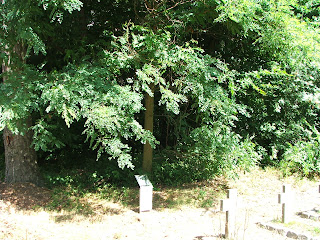Jak już wspominałem pierwotnym miejscem spoczynku części żołnierzy z cmentarza w Krakowie, była nekropolia w Łambinowicach. Tak zwany stary cmentarz jeniecki, gdzie od czasów wojny prusko-francuskiej, czyli od momentu kiedy poligon w Łambinowicach zaczął pełnić funkcje obozu, chowano zmarłych jeńców. Tam też grzebano żołnierzy brytyjskich zmarłych lub zabitych w Stalagu VIII B/ 344 (ci którzy umarli w komandach roboczych byli najczęściej chowani na miejscowych cmentarzach).
As I mentioned earlier, the initial place of the rest of the part of the soldiers from the cemetary in Cracow, was a necropolis in Łambinowice. It was a so-called old prisoners’ cemetary, where from the times of Prussian-French war, that is from the moment when the military training field in Łambinowice started to function as a camp, the dead prisoners were buried there. The British soldiers dead or killed in Stalag VIII B/344 were also buried there (those who died in the work parties were often buried on the local cemetaries).
As I mentioned earlier, the initial place of the rest of the part of the soldiers from the cemetary in Cracow, was a necropolis in Łambinowice. It was a so-called old prisoners’ cemetary, where from the times of Prussian-French war, that is from the moment when the military training field in Łambinowice started to function as a camp, the dead prisoners were buried there. The British soldiers dead or killed in Stalag VIII B/344 were also buried there (those who died in the work parties were often buried on the local cemetaries).
W ostatnia sobotę odwiedziłem Łambinowice, zdjęcia nekropoli można znaleść tutaj:
Jak dziś wygląda część brytyjska? Jak cały cmentarz jest dobrze oznakowana (widać że łambinowickie muzeum dba, co na pewno nie jest łatwe, miejsce jest odludne, w lesie, trawa jednak jest przycięta, czysto, dużo tablic informacyjnych) bez trudu posługując się planem przy wejściu trafiamy na właściwa kwaterę, gdzie znajduje się tabliczka informacyjna.
How does the British part look like today? Like the whole cemetary, it is very well labelled (you can see that a museum in Łambinowice takes care of it, which is not so easy as it is a lonely place, in the forest. The grass is cut, it is also clean. There are many informative boards.) You can reach the right burial plot without any difficulty using the plan near the entrance where the informative board is placed.
How does the British part look like today? Like the whole cemetary, it is very well labelled (you can see that a museum in Łambinowice takes care of it, which is not so easy as it is a lonely place, in the forest. The grass is cut, it is also clean. There are many informative boards.) You can reach the right burial plot without any difficulty using the plan near the entrance where the informative board is placed.
Po ekshumacja i przeniesieniu szczątków przyroda zawłaszczyła sobie (odzyskała?) ten skrawek ziemi. W muzeum zobaczymy jednak zdjęcia i z jednego z pogrzebów i samego cmentarza. Jeńcy brytyjscy chowani byli z pełnym ceremoniałem wojskowym (co jak przedstawiałem już wcześniej należało się i jeńcom żydowskim) zgodnie z konwencją genewską.
After the exhumation and remains moving, the nature regained this part of the ground. However, in the museum we can see the photos taken during one of the burials and the photos of the cemetary itself. The British prisoners of war were buried with the complete military ceremonial (what I mentioned earlier was due to the Jewish prisoners as well) in accordance with the Geneva Convention.
The Soviet prisoners of war, not even during their life or after their death, didn’t have a status of the prisoners. For them , mass and anonymous graves were intended…
After the exhumation and remains moving, the nature regained this part of the ground. However, in the museum we can see the photos taken during one of the burials and the photos of the cemetary itself. The British prisoners of war were buried with the complete military ceremonial (what I mentioned earlier was due to the Jewish prisoners as well) in accordance with the Geneva Convention.
The Soviet prisoners of war, not even during their life or after their death, didn’t have a status of the prisoners. For them , mass and anonymous graves were intended…
Jeńcy radzieccy, ani za życia, ani po śmierci, statusu jeńców nie posiadali. Dla nich były masowe, anonimowe mogiły...



Brak komentarzy:
Prześlij komentarz